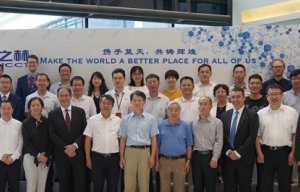
Hexcel opens joint venture laboratory in Shanghai
Pierre Wiertz and Jonathan Bourget discuss market trends, the influence of technology and the role of venture capital.

10th July 2017
Innovation in Textiles
|
Brussels
Pierre Wiertz: We hear a lot about the increasing pace of tech innovation, are business models keeping up?
Jonathan Bourget: Indeed, Industry 4.0 is a reality companies will need to adjust to if they want to succeed in the era of digitisation. I think the way we look at innovation needs to change with the times. In the past, we thought of innovation as a pure product-based activity, led by men in white coats in cluttered labs. The definition has since evolved to include process and marketplace innovation.
Companies need to find new sources of competitive advantage beyond their current business models and to view innovation more holistically than ever. Innovation needs to be integrated within each strategy stream, whether in HR, finance, engineering, supply chain, marketing, etc. However, unless you take an outside-in view of your models, innovation will only be incremental. This is why more companies are setting up separate VC divisions to get the broadest possible view of what is possible.
PW: Technology is often identified as the single biggest disruptor, what are the others major changes that are already affecting the marketplace? Are they affecting our members in the nonwovens sector?
JB: As I mentioned, innovation needs to be embraced by all departments. You can’t have cutting edge technology to manage your manufacturing process if your HR systems still date from the last century. Digitisation is at the core of innovation, providing an opportunity for companies to re-think the way they manage their business processes. Simply taking the old way of doing things and translating them into a digital version of paper-based processes is not innovation. I also think we will see disruption in the way people work - the ‘9-to-5’ model needs to be put to rest in favour of a ‘fluid pool’ of talent that can step in for a given mission, focusing on results rather than processes.
PW: You’re joining us at Outlook this year to discuss corporate venture capital (VC), how would you advise a business on choosing the right time to engage a corporate investor? Is it just for start-ups? And how do you choose the right one?
JB: There are still many misgivings and misunderstandings when it comes to private equity. PE comes in many different, but clearly defined, flavours. Generically, private equity will invest in established businesses, while venture capital is tailored towards the ‘early-stage’ or start-ups. Choosing the right investor is as much a function of your company maturity as it is the reason for seeking outside support.
At Outlook 2017 I will talk about corporate venture capital, which is a fast-growing business model that allows firms to harness innovation in a way their traditional structures cannot. I will discuss some case studies, such as ABB, Siemens, or Johnson & Johnson VC arms and how, by being detached from the legacy enterprise, they have grown an impressive ‘innovation portfolio’ that would otherwise not have been the case.
I will also show why traditional companies have failed in their innovation efforts. Either because of ‘c-suite myopia’, or simply because their aversion to risk has turned them into ‘deer in the headlights’. Of course, some are successful, but many companies treat innovation as a ‘flavour of the month’ initiative, which ultimately kills innovation under a suffocating layer of bureaucracy and creates confusion.
PW: And, conversely, what are the main points to consider in making your business attractive to investors?
JB: Having worked with PE firms for some time now, I can safely say that no two firms take the same approach to evaluation. Generally, a PE firm will want to understand what the growth potential of the target is and what synergies may exist with their other platforms or portfolio companies. I would say the main criteria are: a solid strategic plan with realistic growth targets, a unique market position - being a leader in a given segment - and a functioning executive team.
PW: For larger business looking to diversify, what are the benefits of the venture capital route? What should be the guiding criteria if planning such a move?
JB: Venture capital, as said, is for the early stage or start-ups. For an established company, the right choice will be a private equity partner. There are several benefits to partnering with a PE firm beyond just the capital they can bring. PE firms have a pool of talented operating partners who can take over a management transition situation, they will also provide access to markets and customers that may not otherwise be accessible. I think the biggest strength overall of a PE firm is their network and their razor-sharp governance methodologies.
PW: A lot of the noise around the current generation of VC is centred on online activity. What of the manufacturing sector, and, more specifically, the nonwovens industry?
JB: You are right. Digital is getting a lot of the VC money and attention, but all sectors benefit from the surge of private capital. The industry has grown to such a size that there are now over 2,000 private equity firms in Europe alone. These firms have developed specializations in cleantech, fintech, medtech, infrastructure, real estate, distressed assets amongst others.
With assets under management of over US$ 580 billion, of which US$ 190 billion is dry powder, there is a private equity firm out there that can meet the specific needs of any nonwoven company. Their role could include partnering for a large acquisition, assistance with investment in an unfamiliar territory, help in financing a CAPEX investment, guidance in restructuring a firm, or sale due to a transition in ownership.
Apis Rex, with its broad network of contacts in the industry, can help nonwoven companies in identifying the right partners. Again, PE isn’t only about acquiring businesses, it’s about maximising value realisation.

Business intelligence for the fibre, textiles and apparel industries: technologies, innovations, markets, investments, trade policy, sourcing, strategy...
Find out more